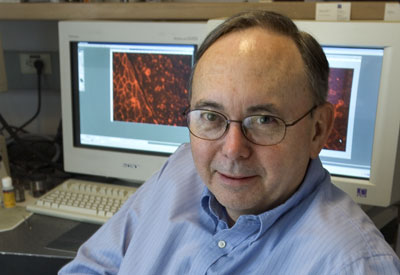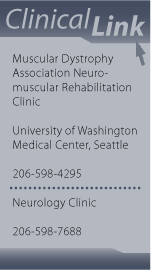Muscular Dystrophy
Treatments for muscle-wasting disease may emerge from molecular and cellular studies
An associated group of proteins inside muscle tissue, the dystrophin complex, is vital to maintaining muscle health and strength. Children, mostly boys, who inherit genetic mutations that upset the form or function of the dystrophin complex can suffer from progressive muscle weakness. Children with severe muscular dystrophy rarely survive into adulthood. They usually succumb when their breathing muscles stop working.

Dr. Stanley Froehner heads studies of why problems with a protein complex called dystrophin lead to muscle cell degeneration.
"Scientists are trying to figure out why problems with the dystrophyn complex lead to muscle cell degeneration," said Dr. Stanley Froehner, professor and chair of physiology and biophysics and one of several UW scientists studying the underlying molecular mistakes in muscular dystrophy. "We will then see if we can use that information to figure out how to treat the disease. Even slowing down the process of degeneration would be of tremendous help." At present, there is no cure, only supportive care.
The search for a cure is taking scientists to the most basic level of muscle biology. They are studying the genetic mutations that result in missing or abnormal proteins in skeletal muscles. Researchers are also learning about the consequences of protein defects on muscle stability. For example, evidence suggests that the muscle membrane may be fragile and easily ruptured during a contraction. Equally intriguing is newer data that suggest that the dystrophin protein complex may be either a signaling entity, or a scaffold on which to attach other proteins required for the signals that keep muscles working. Scientists are also interested in gene mutations or proteins that compensate for the loss of dystrophin complex proteins and lessen muscle degeneration.
Studies on the signaling capabilities of the dystrophin complex, and other research on the production and function of normal and abnormal muscle proteins, may give rise to ideas for undoing the molecular missteps of muscular dystrophy and thereby correct or reduce the severity of muscle wasting. That is the hope of the Molecular and Cellular Therapies for Muscular Dystrophy research program, federally funded this past year at UW Medicine and headed by Froehner.
The program brings together several muscular dystrophy research leaders to examine different aspects of the problem, and to collaborate with biochemists, genome scientists, pharmacologists, pathologists, zoologists, physiologists, neurologists and experts in related fields.
Promising strategies being examined in their labs include altering the mechanisms that code for and regulate gene products, and modifying protein synthesis. Others are looking at modifying the function, transport, and interactions of proteins. Still others are seeking workable methods for cell-mediated therapy, such as encouraging stem cells to replace damaged muscle tissue.
Dr. Jeffrey Chamberlain, professor of neurology, medicine, and biochemistry, will lead one of four major projects in the muscular dystrophy program. His team is exploring the prospect of using stem cell technology for gene therapy. Among obstacles to overcome are the large size of the dystrophin complex, and immune rejection of transplanted cells. Scientists are packaging micro- and mini- versions of dystrophin and muscle promoters into viral vectors - delivery vehicles that can park inside of host cells and make the necessary proteins on the spot - and inserting them into bone marrow cells and muscle precursor cells. The hope is that these cells will turn into muscle cells that produce the dystrophin proteins. Chamberlain's team is also testing the ability of other vectors to stimulate non-muscle cells to become muscle precursor cells, and thereby add new muscle cells to muscle tissue.
Dr. Stephen Hauschka, professor of biochemistry, operates on the hypothesis that no single protein will cure muscular dystrophy. Perhaps what might help is gene therapy that leads to abundant production of a combination of proteins. This combination might substitute for or work around some of the functions of the dystrophin complex, and repair damage resulting from the absence of dystrophin. He is designing regulatory cassettes -- packages tinier than a virus that can be placed inside vectors and sent to muscle cells to control the production of proteins, hopefully for a long time.
Froehner and Dr. Marvin Adams, research assistant professor in physiology and biophysics, will test the signaling capabilities of the dystrophin complex. The alpha-dystrobrevin protein interacts with several parts of the dystrophin complex. This project will outline the role of the normal alpha-dystrobrevin protein, the ways that abnormal forms cause muscle degeneration, and how the absence of alpha-dytrobrevin affects muscle gene activities. The researchers will test whether a form of alpha-dystrobrevin ameliorates muscle degeneration in mice that lack dystrophin.
Dr. Stephen Tapscott, professor of neurology and a Fred Hutchinson Cancer Research Center scientist, is seeking a general approach for identifying control mechanisms for genes that produce muscle proteins, and also the biological mechanisms that regulate gene activity while precursor cells turn into skeletal muscle cells. He is also looking for gene mutations that might compensate for dystrophin deficiency. His aim is to design muscular dystrophy therapies based on manipulating gene expression.
The new Molecular and Cellular Therapies for Muscular Dystrophy program complements UW research on topics ranging from studies of the dystroglycan extracellular communication pathway in fruit flies to investigations of other neuromuscular disorders. The UW and Children's Hospital and Regional Medical Center have clinics for youngsters and adults with muscular dystrophy, and a Muscular Dystrophy Association rehabilitation program.
Development note Funding construction takes a vision of what expanded space, ease of communication, and close collaboration can mean for researchers and patients. A number of generous visionaries are supporting the South Lake Union research hub, among them Jeff and Susan Brotman, Orin Smith, Scott and Laurie Oki, and KeyBank. |
